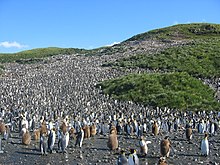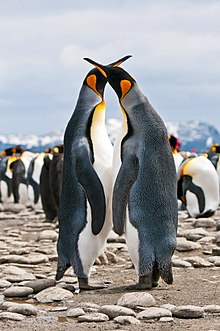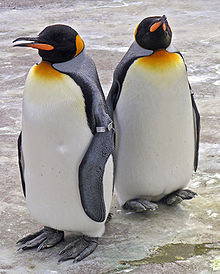King penguins eat small fish, mainly lanternfish, squid and krill. On foraging trips king penguins repeatedly dive to over 100 metres (300 ft), and have been recorded at depths greater than 300 metres (1,000 ft).[3]
King penguins breed on the subantarctic islands at the northern reaches of Antarctica, South Georgia, and other temperate islands of the region.

Appearance
The close-up of A. p. patagonicus subspecies in St. Andrews Bay, South Georgia, British Overseas Territories, UK
At first glance, the king penguin appears very similar to the closely related emperor penguin, with a broad cheek patch contrasting with surrounding dark feathers and yellow-orange plumage at the top of the chest. However, the cheek patch of the adult king penguin is a solid bright orange whereas that of the emperor penguin is yellow and white, and the upper chest tends to be more orange and less yellowish in the king species. Both have colorful markings along the side of their lower mandible, but these tend towards pink in emperor penguin and orange in king penguin. Emperor and king penguins typically do not inhabit the same areas in the wild, with the possible exception of vagrants at sea, but the king can readily be distinguished by being noticeably sleeker, with a longer, straighter bill than the emperor. The chicks of both species are completely different from one another in appearance. Once fully molted of its heavy dark brown down, the juvenile king penguin resembles the adult but is somewhat less colorful.
King penguins often breed on the same large, circumpolar islands as at least half of all living penguins, but it is easily distinguished from co-occurring penguins by its much larger size and taller frame, distinctive markings and grizzled sooty-grayish rather than blackish back.[4][9][10]
Distribution and habitat
Great colony of king penguins on Salisbury Plain in South Georgia
King penguins appear to have suffered a massive population decline of nearly 90% on Île aux Cochons, or Pig Island in the Crozet Archipelago. Analysing new helicopter and satellite images from 2015 and 2017, the colony’s numbers have dropped to 60,000 breeding pairs.[11] The cause of this decline may be due to changes in the ecosystem related to climate change as their primary source of food is moving farther away from places where the penguins can breed. This may result in population declines and shifts in the locations of the King penguin breeding grounds.[12]
The Nature Protection Society released several king penguins in Gjesvær in Finnmark, and Røst in Lofoten in northern Norway in August 1936. Birds were seen in the area several times during the 1940s though none have been recorded since 1949.There were a few unconfirmed sightings of penguins in the area during the early 1950s.[13]
Behavior
King penguin chick
Sound from rookery at Lusitania Bay on Macquarie Island
The king penguin's average swimming speed is 6.5–10 km/h (4–6 mph). On shallower dives under 60 m (200 ft), it averages 2 km/h (1.2 mph) descending and ascending, while on deeper dives over 150 m (490 ft) deep, it averages 5 km/h (3.1 mph) in both directions.[19][22] King penguins also "porpoise", a swimming technique used to breathe while maintaining speed. On land, the king penguin alternates between walking with a wobbling gait and tobogganing—sliding over the ice on its belly, propelled by its feet and wing-like flippers. Like all penguins, it is flightless.[23]
Diet
King penguin moulting, with pin feathers visible
Predators
Miller,JF, 1778

Red: Aptenodytes patagonicus patagonicus
Yellow: Aptenodytes patagonicus halli
Green: breeding areas
The king penguin's predators include other seabirds and aquatic mammals:
- Giant petrels take many chicks of all sizes and some eggs. They have also been reported to occasionally kill adult king penguins, but very likely mostly sick or injured ones. Giant petrels scavenge adult king penguins and chicks which have died from other causes.[24][25]
- Skua species (Stercorarius spp.) take smaller chicks and eggs. Some studies may have overstated the effect skua predation has on king penguin colonies, but large numbers of chicks and eggs are taken in areas where skua nest close to penguin colonies.[26][27][28]
- The snowy sheathbill (Chionis alba) and kelp gull (Larus dominicanus) scavenge for dead chicks and unattended eggs.[29]
- The leopard seal (Hydrurga leptonyx) takes adult birds and fledglings at sea.[30]
- Orcas also hunt king penguins.[31]
- Antarctic fur seals on Marion Island have also been observed chasing king penguins on the beach, killing and eating them. It seems that especially males, and particularly pre-adult males, are involved.[32][33]
Courtship and breeding
A pair of king penguins performs a courtship ritual on Salisbury Plain, South Georgia.
Mating king penguins at Macquarie Island
The king penguin has an extremely prolonged breeding cycle, taking around 14–16 months from laying to offspring fledging.[37] Although pairs will attempt to breed annually, they are generally only successful one year in two, or two years in three in a triennial pattern on South Georgia.[30] The reproductive cycle begins in September to November, as birds return to colonies for a prenuptial moult. Those that were unsuccessful in breeding the previous season will usually arrive earlier. They then return to the sea for around three weeks before coming ashore in November or December.[38]
Aptenodytes patagonicus egg
Hatching may take up to 2–3 days to complete, and chicks are born semi-altricial and nidicolous. In other words, they have only a thin covering of down, and are entirely dependent on their parents for food and warmth.[40] The guard phase begins with the hatching of the chick. Like the closely related emperor penguin, The young king penguin chick spends its time balanced on its parents' feet, sheltered by a pouch formed from the abdominal skin of the latter.[40] During this time, the parents alternate every 3–7 days, one guarding the chick while the other forages for food. The guard phase lasts for 30–40 days. By then the chick has grown much bigger, can keep itself warm and better protect itself against most predators. It becomes more curious and starts to explore its surroundings. It ends up forming a group with other chicks, a so-called crèche. Crèches are guarded by only a few adult birds; most parents can leave their chick to forage for themselves and their chick. Other species of penguins also practice this method of communal care for offspring.
Close-up of king penguin chick.
Unlike emperor penguin chick, covered with brown down.
Unlike emperor penguin chick, covered with brown down.
King penguin chicks
King penguins form huge breeding colonies; for example, the colony on South Georgia Island at Salisbury Plain holds over 100,000 breeding pairs and the colony at St. Andrew's Bay over 100,000 birds. Because of the very long breeding cycle, colonies are continuously occupied year-round with both adult birds and chicks.
The king penguin feeds its chicks by eating fish, digesting it slightly and regurgitating the food into the chick's mouth.
Because of their large size, king penguin chicks take 14–16 months before they are ready to go to sea. This is markedly different from smaller penguins, who rear their chicks through a single summer when food is plentiful. King penguins time their mating so the chicks will develop over the harshest season for fishing. In this way, by the time the young penguins are finally mature enough to leave their parents, it is summer when food is plentiful and conditions are more favorable for the young to survive alone at sea.
Relationship with humans
A pair of king penguin at Edinburgh Zoo
Notable king penguins
- Brigadier Sir Nils Olav, the Edinburgh-based mascot and colonel-in-chief of the Royal Norwegian Guard
- Misha, a central character and metaphor in two novels by Ukrainian writer Andrey Kurkov
- The king penguin is also the species of penguin represented by the popular character Pondus, an image found on various paraphernalia in many retail stores throughout Canada. Pondus originates in Danish children's books written and photographed by Ivar Myrhøj and published in 1997 by Lademann publisher in the late 1960s. These penguins appeared in the production of Batman Returns.
- Lala the Penguin became a viral video star after an Animal Planet special featured him venturing to a nearby market in Japan to fetch a fish with a specially made backpack.[44] Lala had been accidentally caught by a fisherman. The fisherman and his family nursed Lala back to health, then adopted him as a pet.[45]










No comments:
Post a Comment
Note: Only a member of this blog may post a comment.